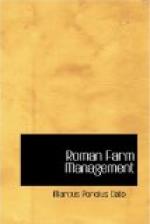Of the considerations on building a steading
a. Size
XI. As the result of faulty surveys of the farm it often happens that the steading is constructed either too small or too large for the farm, a mistake which in either case is of prejudice both to the property and its revenue. If one builds too large or too many buildings he is eaten up by the expense of maintenance, while if one builds less than the farm requires the harvest is lost, for there is no doubt that the largest wine cellar must be provided for that farm on which the vintages are largest, or granary, if it is a grain farm.
b. Water supply
If possible, the steading should be so built that it shall have water within the walls, or certainly near at hand: it is preferable that this should be derived from a spring, or, if not, then from an unfailing stream. If no running water is available a cistern should be constructed within doors, and a pond in the open, the one for the use of the men, the other for the use of the cattle.
c. Location, with regard to health
XII. When you plan to build, try your best to locate the steading at the foot of a wooded hill where the pastures are rich, and turn it so as to catch the healthiest prevailing breeze. The best situation is facing the east so to secure shade in summer and sun in winter. But if you must build on the bank of a river, take care that you do not let the steading face the river, for it will be very cold in winter and unhealthy in summer. Like precautions must be taken against swampy places for the same reasons and particularly because as they dry, swamps breed certain animalculae which cannot be seen with the eyes and which we breathe through the nose and mouth into the body where they cause grave maladies."[68]
“But,” said Fundanius, “suppose I inherited a farm like that, what should I do to avoid the malady you describe?”
“The answer to that question is easy,” said Agrius. “You should sell the farm for what you can get for it: and if you can’t sell it, give it away.”




